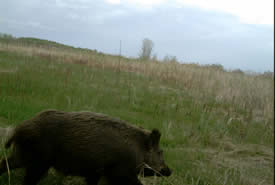Saskatchewan's wild hogs...Not so boar-ing!

Wild boar, SK (Photo by Ryan Brook)
Full-grown can mean well over 200 pounds (90 kilograms) of a fast wild beast with razor-sharp tusks. This exotic roaming species, commonly known as the wild boar and the same species as the pink farm pig, is presenting some challenges to prairie agriculture and our rural natural areas.
Originally of Siberia, these furry, long-legged pigs have adapted well to North American climates. Making nests from cattails and other wetland grasses, they hunker down, store body fat, and easily withstand our cold Saskatchewan winters and hot summers. Illusive as they may seem, sightings of this nocturnal species have recently been reported in more than half of the rural municipalities in Saskatchewan although specific numbers here are currently not known.
Introduced to diversify our agricultural products, their cunning ways, aggressive nature and prolific life cycle (with about two litters of six to eight young per year) causes scientists and ranchers alike to be wary.
A threat to natural diversity
It seems this cunning mammal is able to eat anything — and everything — from nuts and acorns, salamanders and birds’ eggs, even grain, deer and nesting waterfowl. Wild boars also pose a considerable threat to agricultural crops, as whole barley fields can be devoured through a single night of banqueting. The damage, however, also involves their table manners! In wetlands, for example, they root and dig, eating large amounts of native vegetation that was prime wildlife habitat.
Managing NCC's lands for the long term
"Stewardship of the Nature Conservancy of Canada's (NCC's) properties involves much more than assessing for species at risk and managing invasive plants," says Dale Gross, director of conservation with NCC in Saskatchewan. "It’s a watchful, care-induced approach to all invasive species — whether plants, insects, animals, fish or amphibians — that must be taken for long-term protection of these lands."
"They [wild boars] can harass cattle, eat crops, breed like crazy and are a general nuisance. Even the smell of a new person in an area can send this species into hiding, making it difficult to locate," says Ryan Brook, an NCC board member in Saskatchewan and assistant professor with the College of Agriculture and Bioresources, University of Saskatchewan.
Despite its reputation as a nuisance animal, the wild boar's impressive ability to survive and prosper commands admiration. Many are aloof to humans, who may never know they have wild boars living amid their rural backyard.




